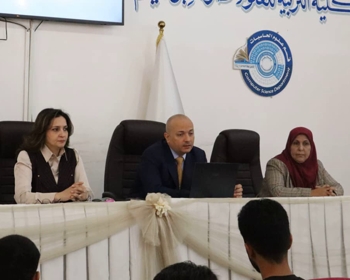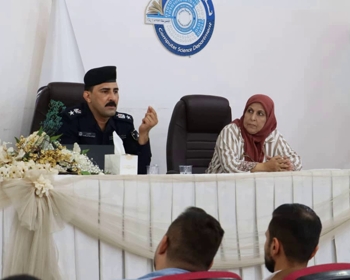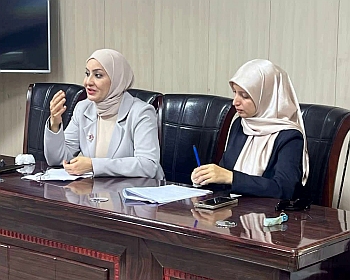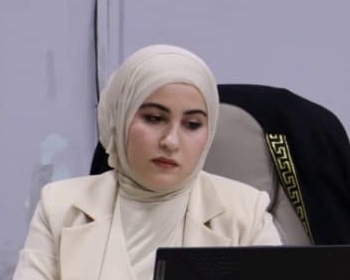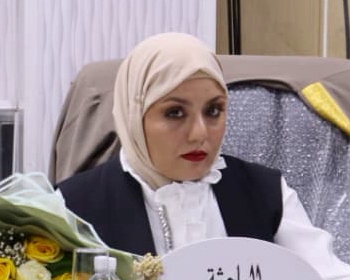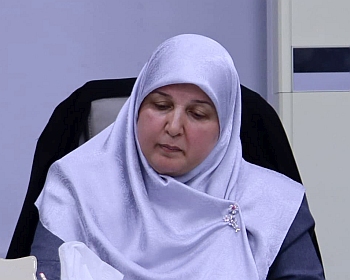ناقش قسم الفيزياء في كلية التربية للعلوم الصرفة (ابن الهيثم) رسالة الماجستير الموسومة (دراسة تحليلية لدرجة حرارة التربة بالنسبة لملوحتها ) للطالب ( مهدي حيدر مهدي صالح ) التي انجزها تحت اشراف التدريسي في القسم ( أ.م.د. حميد مجيد عبد الجبار ).
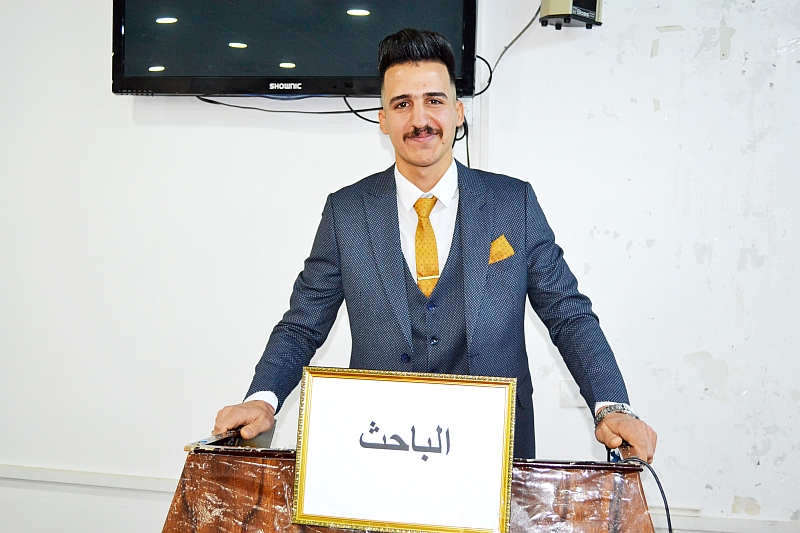
ونوقشت الرسالة من قبل السادة اعضاء لجنة المناقشة :
-
أ.م.د. تغريد عبد الحميد ناجي رئيسا
-
أ.م.د. حازم كاطع دواي عضوا
-
م.د. علي عدنان نعمة عضوا
-
أ.م.د. حميد مجيد عبد الجبار عضوا و مشرفا
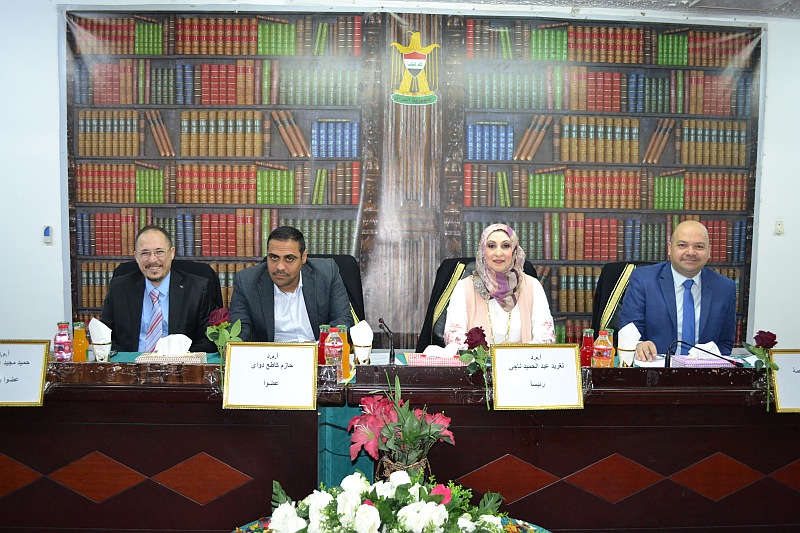
ويهدف البحث الى :
-
الدراسة تغير الملوحة لجميع أشهر العام 2018 وعلاقة هذا التغيير مع درجة الحرارة بعد المعايرة.
-
معرفة خصائص الانعكاس الملحي للتربة المالحة في شمال مدينة بغداد. لدراسة تقلب المناخ وتغير المناخ ، على وجه الخصوص ؛ درجة الحرارة وتأثيرها على ملوحة التربة في بغداد خلال عام 2018.
-
استخدام تقنية كثافة دالة الاحتمالية لربط ملوحة التربة بقيمتها الحرارية كما هو مقترح في هذا العمل البحثي ، وتمنحنا القدرة على مقارنة ملوحة التربة بطريقة تفاضلية اعتمادًا على تباين درجات الحرارة ، وهو ما يمثل طريقة مثيرة للاهتمام لتقييم التربة بسرعة ملوحة منطقة الاهتمام.
وتم في هذه الدراسة عرض العلاقة بين درجة حرارة سطح التربة العارية مقارنتا بملوحتها. غطت الدراسة جميع أشهر سنة 2018 لمنطقة الدراسة المختارة، التي تقع شمال مدينة بغداد بعد فصل التربة العارية فقط من الطبقات الأخرى في المنطقة (المناطق الحضرية والنباتية).
تم استخدام المصنف Support Vector Machen SVM بعد تحويل القيم الرقمية للمرئيات إلى انعكاسية طيفية. بشكل عام، نجح مصنف SVM في تصنيف مكونات الغطاء الأرضي بدقة تتراوح من 88 إلى 98٪.
تم حساب الملوحة الطيفية باستخدام الحزم الطيفية NIR وRED لأن استجابة الملح جيدة في هذه الحزم الموجية كما أكدت معظم الدراسات. تمت معايرة قيم الملوحة المحسوبة طيفيًا بناءً على قيم الملوحة المحسوبة عمليًا عن طريق أخذ عينات من تربة موقع الدراسة في تاريخ مطابق ليوم أخذ العينات 5/3/2019 ومقارنتها بالملوحة المحسوبة طيفيًا لذلك التاريخ.
تم احتساب ملوحة التربة بشكل عملي عن طريق تجفيف عينات التربة وغربلتها بمنخل ذو قياس 1 ملم وقياس الملوحة بوحدات dS / m بعد أخذ ثلاث نسب مئوية من خلط مياه التربة: 1-1، 1-2 و1 -5.
يتم حساب درجة حرارة الغلاف الجوي العلوي (TOA) في منطقة الدراسة بواسطة درجة مئوية، مع مراعاة ارتفاع درجة الحرارة فقط من أدنى درجة حرارة بعد شروق الشمس وحتى اللحظة التي يلتقط فيها القمر الصناعي صورة المشهد.
لتوضيح قيم الملوحة المعايرة ودرجات حرارة السطح المسجلة التي ترتفع بعد شروق الشمس لكل مشهد من أشهر عام 2018، يتم استخدام تقنية تقطيع الألوان لتقسيم نطاق الملوحة ودرجة الحرارة إلى 30 نطاق جزئي، مما يمثل كل نطاق جزئي في نطاق مميز اللون، بدءا من الأحمر إلى الأزرق في ترتيب تصاعدي.
لدراسة العلاقة المتبادلة بين قيم الملوحة المعايرة وارتفاع درجة حرارة السطح بعد شروق الشمس، يتم استخدام تقنية كثافة الاحتمال ثنائية الأبعاد 2D PDF. ويعود السبب في استخدام تقنية 2D كون الأملاح التي تشكل خليط التربة الذي يحتوي على قيم ملوحة معتدلة مع احتمالية كبيرة للظهور وغيرها من الاملاح التي تحتوي على قيم أعلى من الملوحة مع احتمال أقل للظهور، حيث تختلف قيمتها واحتماليتها للظهور تبعًا للموسم ولأنه يعتمد على درجة حرارة ورطوبة التربة. هذه التقنية من خلال ربط ملوحة التربة بدرجة حرارة السطح تمنحنا القدرة على المقارنة التفاضلية بين أنواع التربة المختلفة التي تشكل سطح الأرض من حيث ملوحتها، وهذا يتوقف على الفرق في درجة حرارة السطح.
التوصيات :
-
تحليل تركيبة التربة وإدراجها في صيغة لحساب قيمة الملوحة الطيفية على أساس الطيفية الرنانة من تكويناتها.
-
تطبيق الدراسة على منطقة قاحلة نائية لا تحتوي على خصائص أخرى غير طبقة التربة.
-
استخدام مؤشر رطوبة التربة وتأثيره على قيمة الملوحة بجانب ارتفاع درجة الحرارة.


